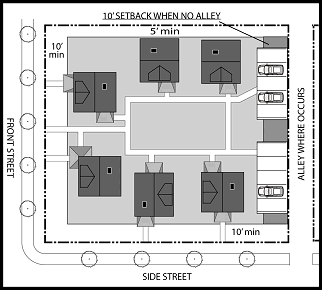20.28.080 Cottage.
A. Description. Cottage housing is a grouping of small compact, detached single-family dwelling units clustered around a common usable area and developed with a shared plan for access and parking, and a coordinated design for the buildings and site.
B. Site Requirements and Setbacks.
1. Cottages may be located on a separate (fee simple) lot or several units may be located on a common parcel. A cottage unit with an ADU must be located on a separated lot.
2. The required setbacks are as shown in Figure 20.28.080(A), except detached accessory buildings may be located in a rear yard and in the rear 22 feet of an interior side yard. Garages and carports shall be set back at least four feet from the street face of residential buildings (excluding front porches). Buildings shall be placed within the shaded areas shown in the figure except as provided above.
C. Bulk and Massing.
1. The minimum is four dwelling units and the maximum is eight dwelling units in a cottage cluster.
2. No structure shall be larger than 1,200 square feet.

Figure 20.28.080(A) Setbacks for Cottage
3. Maximum floor area ratio (FAR) is 0.6. An accessory dwelling unit (ADU) pursuant to BMC 20.10.036 is exempt from FAR.
4. Common shared structures are allowed, limited to the same bulk and mass restrictions as dwelling units, and are exempt from FAR.
5. The height limit is 25 feet under BMC 20.08.020, definition No. 1, or 20 feet under definition No. 2.
D. Usable Space, Open Space and Landscaping.
1. Each dwelling unit shall have at least 100 square feet of private usable space with no dimension less than five feet. Up to 50 square feet of the private usable space may be provided in decks and patios.
2. Private usable space must be directly accessible from the dwelling unit, and be separated from shared spaces or paths and other units through the use of landscaping and/or fencing.
3. Common usable space equivalent to 200 square feet per dwelling unit shall be provided. It shall be consolidated, with a minimum average dimension of 20 feet, exclusive of parking or lanes except for emergency access. All units shall have direct access to common open space.
4. A minimum of 40 percent of the site area shall be in open space consisting of landscaping or permeable materials (may include permeable paving, landscape-based LID BMPs, and green roofs). Exceptions may be made in erosion hazard zones or areas with shallow bedrock as determined by the city.
5. A green factor landscaping score of 0.3 is required (see BMC 20.12.030).
E. Parking. All parking shall be provided pursuant to BMC 20.28.050(H).
F. Design Standards.
1. A front porch with a minimum of 40 square feet and no dimension less than five feet is required for each dwelling unit. This is in addition to the private usable space requirement.
2. Dwelling units that front a public street or lane shall have a porch that faces the street or lane. Units that face the shared open space shall have a porch that faces the open space. In some cases, units will require two front porches to satisfy this criteria.

Figure 20.28.080(B) Annotated Illustration of Cottage
3. Garbage/recycling areas shall be consolidated, unless the local refuse provider approves otherwise, and screened from public view.
G. Design Guidelines. Cottage housing developments should architecturally blend into existing neighborhoods through careful attention to the design of the units, open spaces, parking and landscaping. Well proportioned cottage houses, with porches, small gardens, varied roof lines and dormers can fit comfortably into surrounding neighborhoods of older, detached homes.
1. Building.
a. Buildings should employ variety in orientation, design, and layout between cottages while maintaining a similar character to help distinguish units and support a neighborhood feel.
b. Cottages should reflect common neighborhood design features such as porches, dormers, gables, and architectural detailing.
c. Changes in materials, colors or textures and colors to add visual interest and character to the development are encouraged.
2. Site Design.
a. Provide small private open spaces in conjunction with a large common open space.
b. Provide generous use of landscape structures such as trellises, gate houses, decks, patios, and raised beds to provide plenty of usable outdoor space with a variety of environments. Use planting materials and elements such as fencing to unify the overall site design.
c. Shared driveways are preferred.
d. Walkways should connect all dwelling units to the common open space and consolidated parking and should utilize pervious materials. [Ord. 2022-01-002 § 11; Ord. 2017-03-009 § 21; Ord. 2009-08-047].